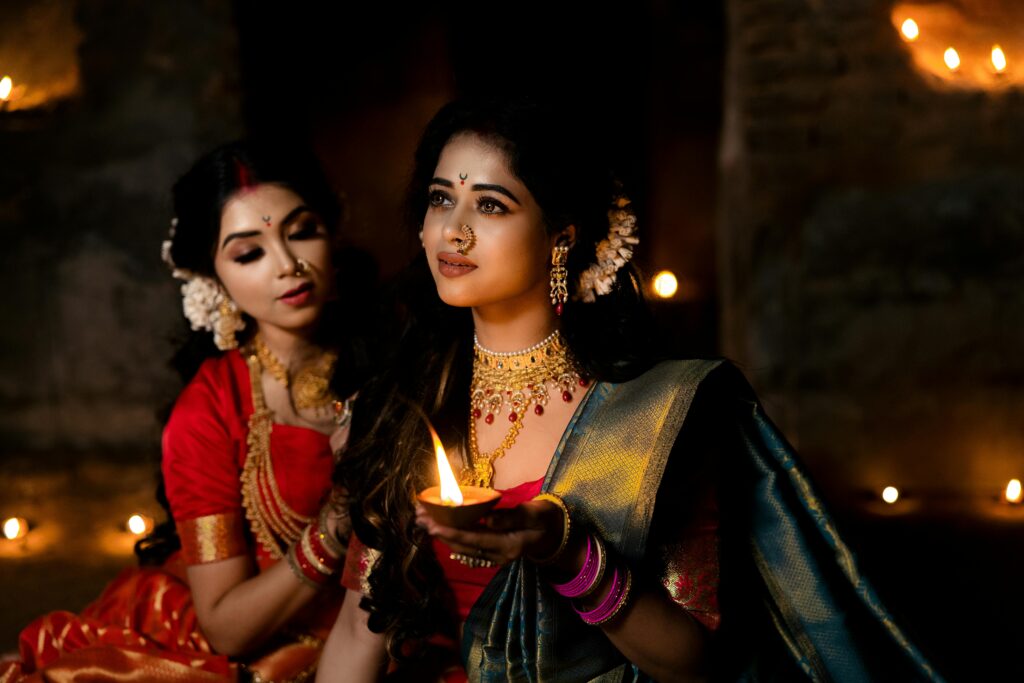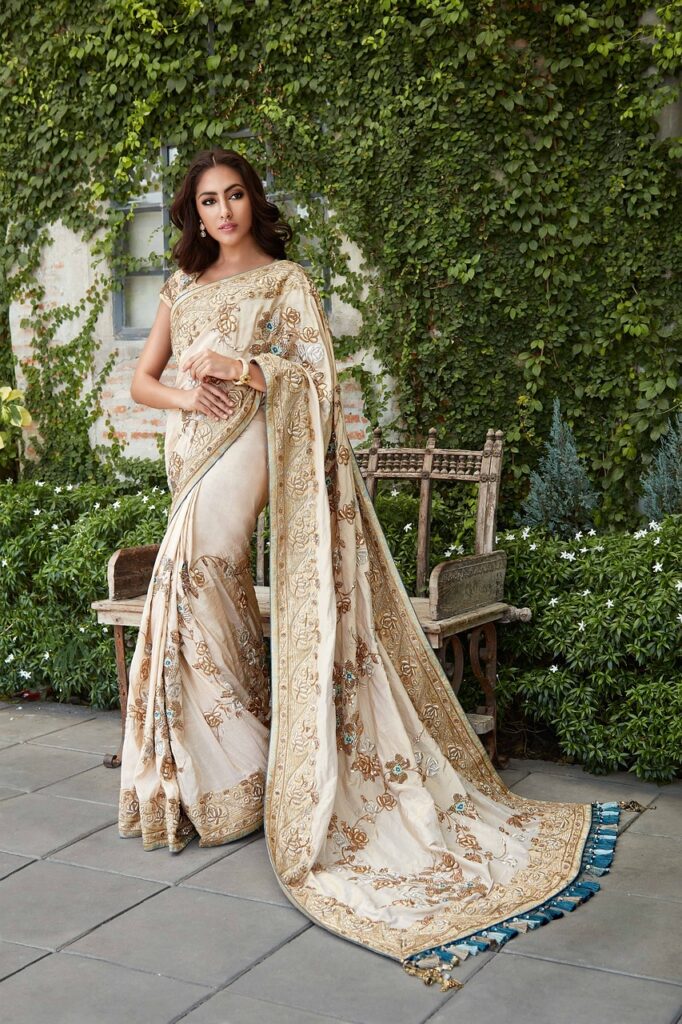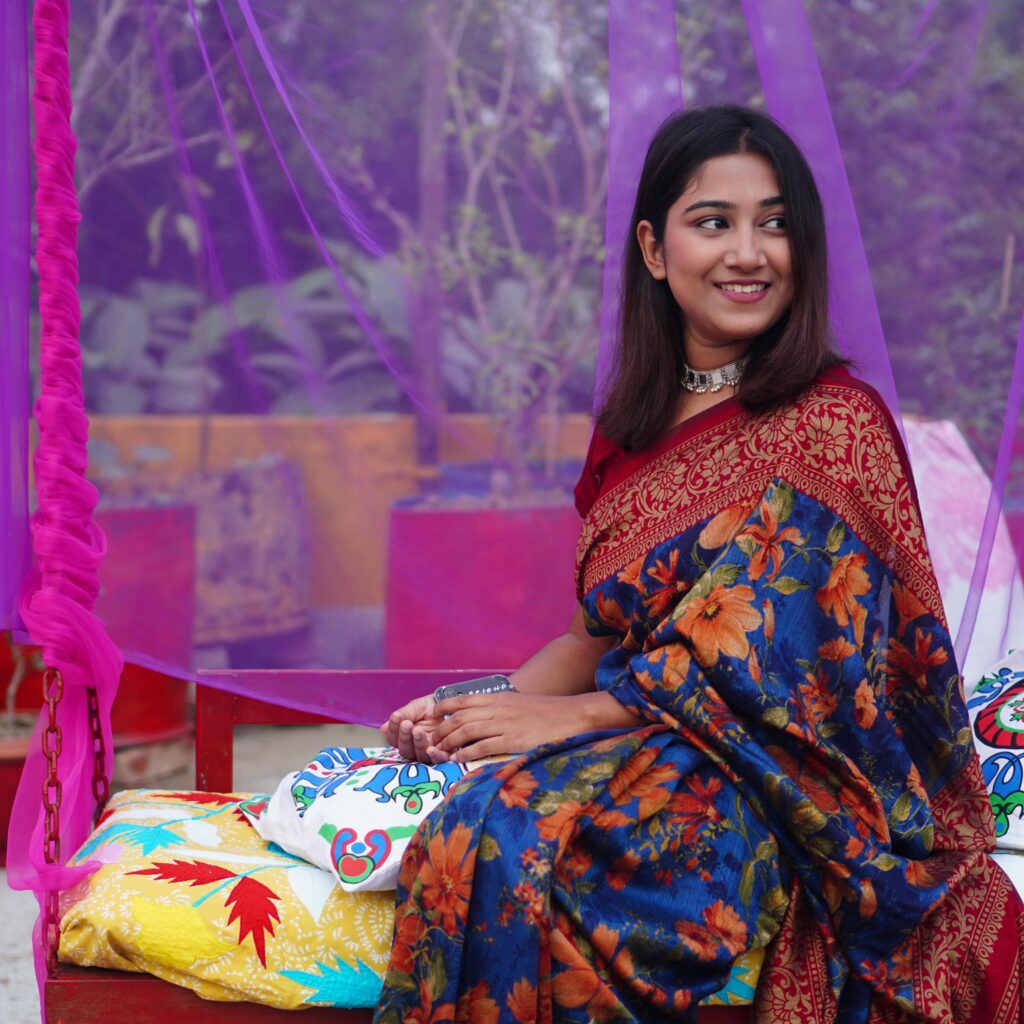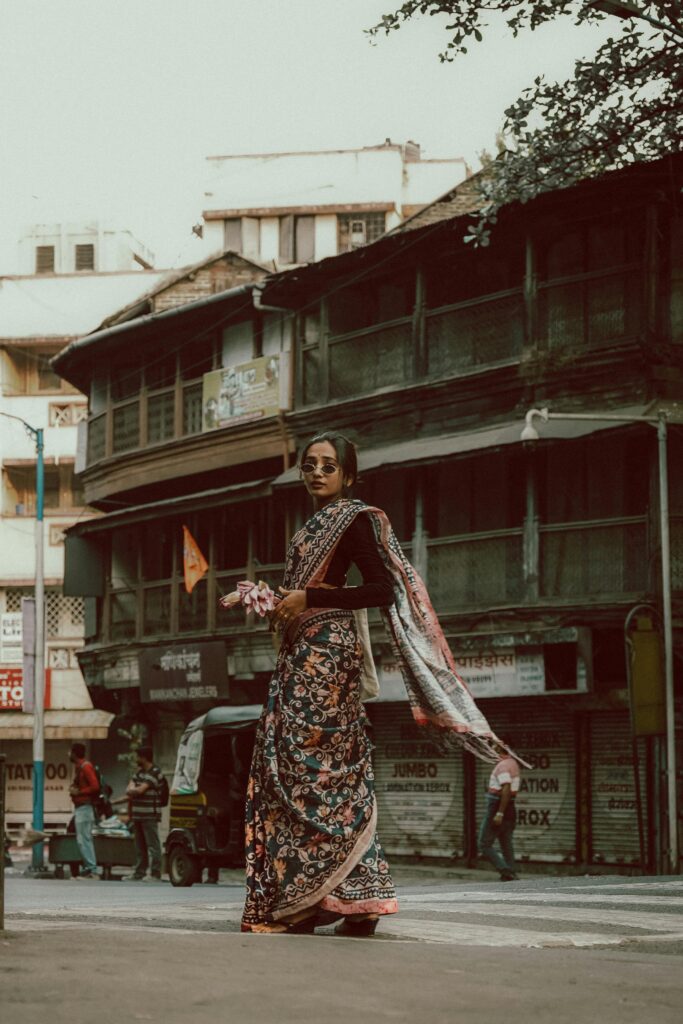The saree, an iconic garment that has been a cornerstone of Indian fashion for centuries, is a beautiful blend of tradition, culture, and style. It transcends regional, religious, and social boundaries, representing the rich and diverse heritage of India. Whether draped in the classic style of saree or reinvented with modern twists, the saree continues to captivate and inspire across generations.
A Glimpse into the History of Sarees

The history of the saree can be traced back over 5,000 years. Ancient Indian texts, sculptures, and paintings depict women wearing garments that resemble the modern-day saree. It is believed to have evolved from a unstitched cloth, draped in various styles across different regions.
The traditional saree, typically five to nine yards long, is a piece of cloth that is skillfully draped around the body, often over a petticoat, with the end portion (called the pallu) thrown over the shoulder. The elegance of the saree lies not just in its fabric and design, but in the way it is worn, making every drape unique to the wearer.
Fabric Variety: The Heart of a Saree

One of the most fascinating aspects of sarees is the wide array of fabrics used in their creation. Each fabric adds its own charm and significance to the saree, making it perfect for different occasions.
Silk Sarees: Known for their luxurious feel and rich texture, silk sarees are a staple for festive occasions, weddings, and celebrations. They are often intricately woven with gold or silver threads, making them an opulent choice.
Cotton Sarees: A symbol of comfort and elegance, cotton sarees are ideal for everyday wear. They are lightweight, breathable, and come in a variety of vibrant colors and prints. Cotton sarees are often associated with hot, tropical climates and are a perfect choice for the summer season.
Chiffon and Georgette Sarees: These lightweight, flowy fabrics are often chosen for their graceful drape and ethereal appeal. Chiffon and georgette sarees are perfect for evening wear, creating an understated yet sophisticated look.
Banarasi Sarees: Originating from Varanasi, Banarasi sarees are known for their intricate brocade work, often featuring motifs like paisleys, florals, and vines. These sarees are frequently worn for weddings and are a symbol of grandeur.
Kanjivaram Sarees: Hailing from Tamil Nadu, Kanjivaram silk sarees are renowned for their lustrous texture and exquisite craftsmanship. These sarees are a common choice for South Indian brides and are often crafted with gold borders and intricate designs.
Draping Styles: A Personal Touch
While the fabric is essential, the way a saree is draped can dramatically alter its appearance. There are various draping styles across different regions of India, each with its own flair and significance.
Bengali Style: In this style, the pallu is draped across the front and worn over the right shoulder. The pleats are tucked in at the back, giving the wearer a graceful and regal appearance.
Nivi Style (Andhra Pradesh, Telangana): This is the most widely worn saree style. The saree is draped with the pallu thrown over the left shoulder, allowing for comfort and ease of movement.
Maharashtrian Style: The Maharashtrian saree, or Nauvari saree, is a 9-yard saree draped in a way that resembles a dhoti. This style is often paired with traditional jewelry and accessories.
Gujarati Style: In this style, the pallu is draped over the right shoulder and the saree is tucked in a way that allows the wearer to move freely, while showcasing the intricate border designs.
Lehenga Saree: A fusion of the saree and lehenga, the lehenga saree is a modern style where the saree is draped in the form of a lehenga skirt, with the pallu casually thrown over the shoulder. This style has gained popularity for its ease of wear at contemporary celebrations.
Sarees for Every Occasion

Sarees are incredibly versatile and can be worn for a variety of occasions, each with a distinct style and presentation.
Weddings: Traditional sarees such as Banarasi, Kanjivaram, or even heavily embroidered lehenga sarees are often chosen for weddings. These sarees are adorned with intricate work, heavy borders, and vibrant colors that make the bride stand out.
Festivals: During festivals like Diwali, Durga Puja, and Navratri, women often wear sarees made of cotton or silk. Sarees in rich colors like gold, red, and green are favored, symbolizing prosperity and good fortune.
Workwear: For professional settings, subtle cotton or silk sarees in pastel shades with minimal embellishments work well. These sarees maintain elegance while offering comfort for long hours at work.
Casual and Everyday Wear: Cotton sarees with simple patterns and light colors are perfect for daily wear. They are practical, stylish, and can easily be worn with minimal effort.
Sarees in the Modern World

While the saree has deep cultural and historical roots, it has also evolved over time to cater to contemporary tastes. Designers are constantly experimenting with new fabrics, styles, and techniques to give the saree a modern touch. From sarees with pre-stitched pleats for ease of wear to creative takes on traditional styles, the saree is making waves on the international fashion scene.
Bollywood and the fashion industry have played a significant role in reviving the saree’s popularity, with many celebrities endorsing it for red carpet events, film promotions, and even casual outings. Sarees are no longer just traditional attire; they have become a symbol of timeless elegance, transcending age and cultural boundaries.
Conclusion: A Legacy of Grace

The saree is more than just a piece of clothing; it is a testament to the rich cultural tapestry of India. Whether worn as a symbol of tradition or a statement of style, the saree continues to captivate people around the world. With its versatile nature, intricate craftsmanship, and timeless elegance, the saree is destined to remain a beloved wardrobe staple for generations to come.
So, whether you’re a saree enthusiast or a first-time wearer, embrace the beauty of this magnificent garment. After all, every saree tells a story—of heritage, craftsmanship, and the individuality of the woman who wears it.
The Importance of Sarees in Indian Women’s Life
The saree is not just a piece of clothing in India; it is a symbol of tradition, culture, and identity that holds immense significance in the lives of Indian women. Worn for centuries, it transcends time, regions, and communities, playing an integral role in the personal and social life of women across the country. The saree is more than just an attire; it is a medium through which women express themselves, uphold family traditions, and embrace their cultural heritage. In this essay, we explore the many reasons why sarees hold such an important place in Indian women’s lives.
1. Cultural and Historical Significance
The saree has been a part of Indian culture for thousands of years. Its history can be traced back to the Indus Valley Civilization, where evidence of women wearing unstitched garments resembling modern-day sarees has been found. The garment is deeply embedded in Indian tradition and history, reflecting the continuity and evolution of Indian culture. For many women, wearing a saree is an expression of their deep connection to their roots, the rich history of their ancestors, and the cultural practices passed down through generations.
India’s diverse regions have unique styles of draping and fabric choices for sarees, which further emphasize regional pride and cultural diversity. A woman’s choice of saree often reflects her cultural and geographical identity, showcasing the varied techniques of weaving, embroidery, and textile production that are prevalent in different parts of India. From the Kanjeevarams of Tamil Nadu to the Banarasi sarees of Varanasi, the saree is a canvas of India’s rich cultural heritage.
2. Symbol of Tradition and Values
In Indian society, the saree represents tradition and is often worn during significant cultural and religious occasions. For many women, donning a saree is a rite of passage, marking milestones such as weddings, festivals, and religious ceremonies. Weddings are a prime example, where the saree, especially the bridal saree, holds a special place in the heart of every Indian woman. The saree worn on a woman’s wedding day is not merely a garment; it symbolizes her new role in society, her family’s status, and a new chapter of life.
During major festivals such as Diwali, Durga Puja, and Navratri, the saree is an integral part of the celebration. The vibrant colors, intricate designs, and careful draping of the saree make these occasions even more special. In many households, the saree is passed down from one generation to the next, preserving family traditions and fostering a sense of continuity and legacy.
3. Empowerment and Self-expression
Wearing a saree allows Indian women to express their individuality while adhering to the boundaries of tradition. The wide variety of fabrics, colors, patterns, and draping styles give women the freedom to choose a saree that reflects their personal style and preferences. Whether it is a simple cotton saree for a casual day or an ornate silk saree for a formal occasion, the saree allows women to present themselves with confidence and grace.
For many women, the act of draping a saree is a form of self-expression. It is a skill that takes practice and expertise, and mastering the art of draping a saree can be empowering. The sense of pride that comes with wearing a well-draped saree is a testament to the woman’s mastery of her cultural identity. In urban India, women often wear sarees in contemporary and innovative ways, merging tradition with modernity and showcasing their versatility.
4. A Representation of Femininity and Elegance
The saree is often seen as a representation of femininity and elegance. It accentuates the natural form of a woman’s body, highlighting her grace and poise. The way a woman carries herself in a saree exudes confidence and charm, making it a garment that elevates her presence in any setting. Whether worn casually or for formal occasions, the saree has a unique ability to make the woman feel both graceful and empowered.
The saree’s beauty lies in its simplicity and versatility. Unlike Western attire, which typically comes in standard cuts, the saree offers a more fluid and dynamic design, giving women the ability to move freely while still looking elegant. This aspect of the saree makes it both practical and aesthetically pleasing, making it suitable for both daily wear and special occasions.
5. Social and Family Connections
In many Indian families, the saree is more than just a piece of clothing; it plays an important role in maintaining social and familial bonds. When a woman wears a saree, it is often seen as a way of showing respect to elders and honoring family traditions. In some families, women may wear specific sarees during important events to maintain a sense of unity and continuity with past generations.
The gifting of sarees is also a significant practice within Indian culture. Women are often gifted sarees by family members on birthdays, anniversaries, or other special occasions. These sarees are treasured not only because of their material value but also because they represent the love and affection of the giver. The tradition of gifting sarees helps to strengthen familial ties and keeps the spirit of tradition alive within households.
6. The Role of the Saree in Changing Times
While the saree is traditionally associated with Indian women, it has evolved over time to fit into modern lifestyles. Women today are choosing sarees not just for festivals or family gatherings but also for professional settings, television appearances, and even international events. The saree, once perceived as cumbersome and old-fashioned by some, is now seen as a symbol of national pride and individuality in global fashion.
Indian designers have also played a pivotal role in reinventing the saree. By experimenting with fabrics, cuts, and contemporary draping styles, they have breathed new life into this traditional garment. Modern Bollywood actresses have popularized sarees on international platforms, contributing to the garment’s newfound global appeal. The saree’s ability to adapt to modern tastes while retaining its traditional charm is a testament to its timeless nature and versatility.
7. A Source of Economic Importance
The production and sale of sarees also hold significant economic importance for India. The saree industry, encompassing handlooms, silk production, and textile weaving, supports millions of artisans and workers across the country. Weaving and dyeing are traditional skills passed down through generations, and the saree is one of the key products that sustain these local industries.
Handwoven sarees, in particular, are a major source of income for artisans in rural India. By wearing and buying sarees, women contribute to the preservation of these age-old crafts and help sustain the livelihoods of many families. The saree thus plays an indirect role in supporting India’s traditional craft industry and sustaining economic development in rural regions.
Conclusion
In conclusion, the saree holds a deeply ingrained place in the life of Indian women, representing tradition, culture, elegance, empowerment, and social connection. It is a garment that transcends generations and has withstood the test of time. For Indian women, the saree is more than just clothing; it is a celebration of their identity, heritage, and the diversity of their culture. Whether worn for daily activities, special occasions, or celebrations, the saree remains a cherished symbol of femininity, grace, and pride. As India continues to evolve, so too does the saree, maintaining its relevance and significance in the modern world while staying true to its cultural roots.